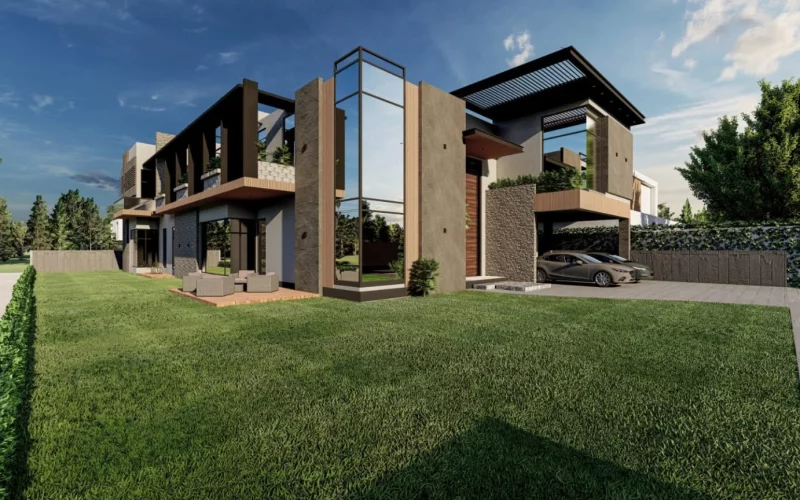Building a house is one of the biggest dreams for many families in Pakistan. It is not just about putting up walls and a roof—it is about creating a safe and comfortable space to live. Many people want to build their own homes with the help of a skilled architect and an experienced construction company to guide them.
If you are planning to build your own house or just want to understand how it works, this article will explain everything in a simple, step-by-step way. From planning to finishing, we will walk you through the whole process using common words and local examples.
Step 1: Planning and Budgeting
Before any work starts, the first step is planning.
-
Site Selection: Choose a plot where you want to build your house.
-
Budget Estimate: Know how much you can spend. It includes land cost, construction cost, fees, and materials.
-
Hiring Professionals: Meet with an architect to design your home. Also, find a reliable construction company for the actual building work.
This step is very important as it sets the base for the whole project.
Step 2: House Design and Map Approval
Once the land is selected and the budget is set, the next step is designing the house.
-
Architectural Drawing: The architect prepares a house map according to your needs. This includes room sizes, layout, ventilation, and sunlight direction.
-
Structural Drawing: Engineers prepare this drawing to ensure the structure is strong and safe.
-
Government Approval: The design must be submitted to the local authority (like the development authority) for approval. You cannot build without this.
A qualified architect helps in creating beautiful, practical designs that meet building rules.
Step 3: Groundbreaking and Site Preparation
Once the map is approved, it’s time to prepare the site for construction.
-
Clearing Land: Remove any trees, debris, or old construction.
-
Marking Boundaries: The area where the house will be built is marked with ropes and chalk lines.
-
Temporary Facilities: A small room for workers and a water tank may be set up for construction use.
Step 4: Foundation Work
The foundation is the most important part of a building. It supports the whole structure.
-
Excavation: Digging is done according to the design for the base of the house.
-
Footings: Concrete is poured into the dug space to create strong footings.
-
PCC (Plain Cement Concrete): A layer of concrete is laid to prepare for steel and columns.
A trusted top construction company ensures this work is done accurately, as a weak foundation can cause big problems later.
Step 5: Grey Structure Work
This is the main construction phase where the house starts taking shape.
a. Steel and Shuttering
-
Steel bars (Saria) are placed in columns and beams.
-
Shuttering is wooden or steel boards used to hold concrete in shape.
b. Column Casting
-
Concrete is poured into shuttering to make strong vertical columns.
c. Brickwork and Walls
-
Red clay bricks are used to build walls.
-
Cement and sand mortar binds the bricks together.
d. Slab Casting
-
Concrete slabs are poured for the roof and each floor level.
This stage involves heavy work and labor. A good construction company will have a trained team to manage this. Whether you’re constructing a home or a commercial project, many firms offer top Commercial construction services and best Residential construction services to meet your specific needs.
Step 6: Plumbing and Electrical Work
After the grey structure is ready, internal work begins.
-
Plumbing Lines: Water supply, sewer, and drainage pipes are installed.
-
Electrical Wiring: Wires for fans, lights, and sockets are placed in the walls.
-
Gas Lines: If Sui gas is planned, pipes are installed during this time.
This step must be done before plastering to avoid breaking walls later.
Step 7: Plastering and Flooring
Once the internal lines are fixed, walls and floors are finished.
-
Plastering: A mix of sand and cement is applied to smooth the walls.
-
Flooring: Marble, tiles, or chips are laid. Many houses use ceramic tiles or granite marble for a shiny look.
A skilled team ensures the finish is smooth and neat.
Step 8: Doors, Windows, and Grills
Now the house starts to look like a real home.
-
Wooden doors and metal windows are installed.
-
Safety grills are added to windows for security.
-
Local woods like Sheesham are often used for doors in Pakistani homes.
These elements are both functional and decorative.
Step 9: Paint and Final Finishing
This is the last step before you can move in.
-
Interior Painting: Walls are painted in soft or bright colors, depending on taste.
-
Exterior Paint: A weather-resistant paint is used outside.
-
False Ceiling: Many homes now have POP false ceilings for better design.
-
Kitchen and Bathroom Fittings: Sinks, commodes, taps, and cabinets are installed.
At this point, many people also hire best interior designers to make the home look beautiful and modern. A qualified architect often works together with the interior designer to complete the final touches.
Step 10: Inspection and Handover
Once everything is complete:
-
Final Inspection: The house is checked for any problems like water leaks or cracks.
-
Cleaning: The site is cleaned before shifting.
-
Move-In: Now you are ready to start living in your new home.
Some best construction companies offer full supervision till the handover to ensure nothing is left incomplete.
Important Tips for Home Builders in Pakistan
-
Always have a written contract with your architect and builder.
-
Visit the site regularly to monitor progress.
-
Use only approved materials like branded cement, steel, and paint.
-
Ask your construction company for regular updates.
-
Plan your house according to family size and future needs.
Conclusion
Building a house step by step is a detailed process, but it becomes easier when you have the right help. From planning and designing with a trusted architect to completing construction with a reliable construction company, every step needs care, patience, and teamwork.
If you follow the steps properly and use good materials, your house will be strong, safe, and beautiful. A home is not just made of bricks and cement—it is made with love, planning, and the right people.
Whether you are building in a city or rural area, this step-by-step guide can help you understand what to expect at each stage. Happy building!












